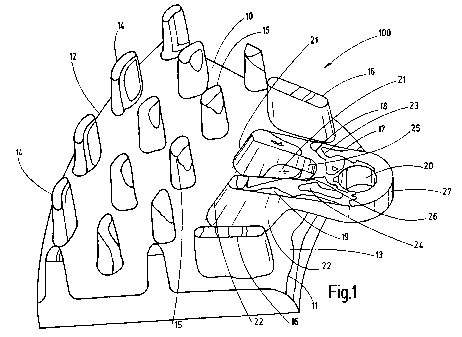Une partie des informations de ce site Web a été fournie par des sources externes. Le gouvernement du Canada n'assume aucune responsabilité concernant la précision, l'actualité ou la fiabilité des informations fournies par les sources externes. Les utilisateurs qui désirent employer cette information devraient consulter directement la source des informations. Le contenu fourni par les sources externes n'est pas assujetti aux exigences sur les langues officielles, la protection des renseignements personnels et l'accessibilité.
L'apparition de différences dans le texte et l'image des Revendications et de l'Abrégé dépend du moment auquel le document est publié. Les textes des Revendications et de l'Abrégé sont affichés :
| (12) Demande de brevet: | (11) CA 2701328 |
|---|---|
| (54) Titre français: | DISQUE DE FREIN |
| (54) Titre anglais: | BRAKE DISC |
| Statut: | Réputée abandonnée et au-delà du délai pour le rétablissement - en attente de la réponse à l’avis de communication rejetée |
| (51) Classification internationale des brevets (CIB): |
|
|---|---|
| (72) Inventeurs : |
|
| (73) Titulaires : |
|
| (71) Demandeurs : |
|
| (74) Agent: | MBM INTELLECTUAL PROPERTY AGENCY |
| (74) Co-agent: | |
| (45) Délivré: | |
| (86) Date de dépôt PCT: | 2008-07-15 |
| (87) Mise à la disponibilité du public: | 2009-04-09 |
| Licence disponible: | S.O. |
| Cédé au domaine public: | S.O. |
| (25) Langue des documents déposés: | Anglais |
| Traité de coopération en matière de brevets (PCT): | Oui |
|---|---|
| (86) Numéro de la demande PCT: | PCT/EP2008/005762 |
| (87) Numéro de publication internationale PCT: | EP2008005762 |
| (85) Entrée nationale: | 2010-03-29 |
| (30) Données de priorité de la demande: | ||||||
|---|---|---|---|---|---|---|
|
L'invention concerne un disque de frein (100), comprenant une bague de friction plane (10) sur laquelle est formé un ergot de disque de frein (17) pourvu d'un perçage d'ergot (20). L'invention vise à perfectionner le disque de frein (100) de manière à obtenir une sécurité suffisante relativement aux valeurs de matériau admissibles pour des disques de frein (100) destinés à des applications hautement énergétiques, et à réduire les tensions du matériau qui sont produites dans la région de l'ergot de disque de frein (17) du disque de frein (100) par des différences de température à l'intérieur du disque de frein (100) suite à des apports élevés d'énergie de freinage. A cet effet, l'ergot de disque de frein (17) présente deux parties de bras (18, 19), qui s'étendent à distance entre elles depuis la bague de friction plane (10) en direction du perçage d'ergot (20) et qui se rejoignent avant le perçage d'ergot (20).
The invention relates to a brake disc (100) having a face-end friction ring
portion (10) on which a brake disc cam (17) provided with a cam bore (20)
is moulded. In order to further develop the brake disc (100) in such a
manner that adequate safeties with respect to the permissible material
values on brake discs (100) for high-energy application cases are provided
and material stresses in the region of the brake disc cam (17) of the brake
disc (100), which are caused through temperature differentials within the
brake disc (100) as a consequence of high braking energy inputs, are
reduced, the invention proposes that the brake disc cam (17) comprises
two arm parts (18, 19) which extend spaced from each other from the
face-end friction ring portion (10) in the direction of the cam bore (20) and
converge in front of the cam bore (20).
Note : Les revendications sont présentées dans la langue officielle dans laquelle elles ont été soumises.
Note : Les descriptions sont présentées dans la langue officielle dans laquelle elles ont été soumises.

2024-08-01 : Dans le cadre de la transition vers les Brevets de nouvelle génération (BNG), la base de données sur les brevets canadiens (BDBC) contient désormais un Historique d'événement plus détaillé, qui reproduit le Journal des événements de notre nouvelle solution interne.
Veuillez noter que les événements débutant par « Inactive : » se réfèrent à des événements qui ne sont plus utilisés dans notre nouvelle solution interne.
Pour une meilleure compréhension de l'état de la demande ou brevet qui figure sur cette page, la rubrique Mise en garde , et les descriptions de Brevet , Historique d'événement , Taxes périodiques et Historique des paiements devraient être consultées.
| Description | Date |
|---|---|
| Demande non rétablie avant l'échéance | 2011-07-15 |
| Le délai pour l'annulation est expiré | 2011-07-15 |
| Inactive : Demande sous art.37 Règles - PCT | 2011-06-27 |
| Réputée abandonnée - omission de répondre à un avis sur les taxes pour le maintien en état | 2010-07-15 |
| Inactive : Page couverture publiée | 2010-06-03 |
| Inactive : Lettre de courtoisie - PCT | 2010-05-26 |
| Inactive : Notice - Entrée phase nat. - Pas de RE | 2010-05-26 |
| Inactive : CIB attribuée | 2010-05-25 |
| Inactive : CIB en 1re position | 2010-05-25 |
| Demande reçue - PCT | 2010-05-25 |
| Exigences pour l'entrée dans la phase nationale - jugée conforme | 2010-03-29 |
| Demande publiée (accessible au public) | 2009-04-09 |
| Date d'abandonnement | Raison | Date de rétablissement |
|---|---|---|
| 2010-07-15 |
| Type de taxes | Anniversaire | Échéance | Date payée |
|---|---|---|---|
| Taxe nationale de base - générale | 2010-03-29 |
Les titulaires actuels et antérieures au dossier sont affichés en ordre alphabétique.
| Titulaires actuels au dossier |
|---|
| FAIVELEY TRANSPORT WITTEN GMBH |
| Titulaires antérieures au dossier |
|---|
| HEINZ-JUERGEN GASPERS |
| HELMUT HOFFMANN |